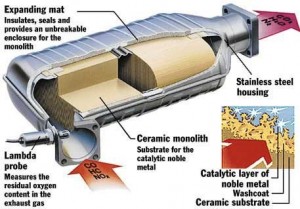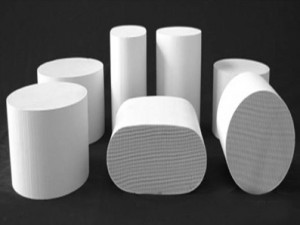With the advent of emission control regarding vehicle exhaust came the need to ‘scrub’ environmentally  harmful gases before emitting the products of combustion into the atmosphere. Your Catalytic Converter , part of the vehicle’s exhaust system, is designed to either reduce or oxidize (through chemical reaction) the noxious gases using catalysts. Should your “Check Engine” light be illuminated, chances are there is a problem with your catalytic converter – it is essential that the expert technicians at Everett Catalytic Converter diagnose and repair your exhaust system immediately!
harmful gases before emitting the products of combustion into the atmosphere. Your Catalytic Converter , part of the vehicle’s exhaust system, is designed to either reduce or oxidize (through chemical reaction) the noxious gases using catalysts. Should your “Check Engine” light be illuminated, chances are there is a problem with your catalytic converter – it is essential that the expert technicians at Everett Catalytic Converter diagnose and repair your exhaust system immediately!
Although emission control is not monitored in every county in Washington state, by doing your part, voluntarily, emissions testing may never be necessary. Think about it: if every vehicle owner were to assure proper operation of the catalytic converter(s) – collectively, vehicle emissions will remain low enough that testing becomes irrelevant. Understanding the elegant design  of a catalytic converter is recommended to grasp the true value of how this component helps to clean the world’s air. Just as important is learning the primary reasons for catalytic converter failure.
of a catalytic converter is recommended to grasp the true value of how this component helps to clean the world’s air. Just as important is learning the primary reasons for catalytic converter failure.
The internal core, or substrate, of a catalytic converter is often the component that fails. Although the housing is vulnerable to damage as well. The 4 most common reasons for catalytic converter failure include:
1. Overheated Substrate
A substrate that is overheated for extended periods of time will eventually melt and/or fail. The most common causes of substrate melting/overheating are:
- Worn or failed O2 sensor causing poor fuel control
- Air cleaner restricted
- Fuel quality is substandard
- Engine load is excessive
- Inadequate engine compression
- Inadequate spark
- Weak ignition
- Hydrocarbons
- Oxygen (O2)
- Carbon Monoxide (CO)
- Leaded Gasoline – using in a vehicle with a catalytic converter will cause catastrophic damage; the fuel lines must be flushed or replaced should this happen.
- Antifreeze – if present in the exhaust system indicates a leaks within both the cooling and the exhaust system, the leaks must be located and repaired immediately. Cross-contamination can cause severe damage to both systems.
- Zinc (present in some oil additives) – carefully read all labels to insure no zinc is present
- Certain silicon sealants – carefully read all labels to insure no zinc is present
- Metal fatigue from heating/cooling cycle of engine use in winter conditions (quenching action of driving through cold water when engine is operating at normal temperature)
- Corrosion from chemicals like road salt
- O2 sensor plug not operating properly (stripped)
- Pipe joint failure at either/or the inlet and outlet


Great service and great mechanics